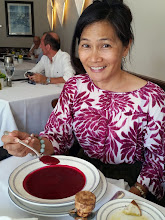Braising is grilling's more sophisticated cousin. The flavors and aesthetics of barbeque tend to be showy and brash - perhaps having to do with the fact that open flames, a backyard, and a lot of beer are generally involved. In "Cooked: A Natural History of Transformation," Michael Pollan says that the "braise or boil, since it cooks meat all the way through, achieves a more complete transcendence of the animal, and perhaps the animal in us, than does grilling over a fire, which leaves its object partly or entirely intact... a visible reminder, in other words, that this is a formerly living creature we're feasting on."
 |
Pearls before wine: This coq au vin recipe had many steps,
all of them worth the effort! |
Like the present-day protagonist of "Julie and Julia," I was (and probably still am) intimidated by the complexities of Julia Child's "Mastering the Art of French Cooking." When I decided that it was time to learn how to make
coq au vin, I had originally planned to do the slow cooker version of a recipe that I found online. But ironically, I did not have enough time that lazy Sunday afternoon after doing the shopping to allow the dish the five-and-a-half hours that the slow cooker recipe required. So I decided to cook it on the stove, and to go rogue and break one of those cardinal kitchen rules - never serve a dish you've never made before - and invite the neighbors over for dinner.
It's not entirely true that I have never made coq au vin before. In my misspent youth, I attempted it from a recipe in a cookbook that came with a CD of ersatz French cafe tunes, seduced by the knowledge that cooking with wine sounded like a very grownup thing to do. I remember going through two or three bottles of a cheap red from Trader Joe's (there are very good "cheap reds" at TJ's, but this wasn't one of them!) and ending up with some indistinguishable bits of purple, overly salty chicken in the bottom of a charred Dutch oven.
 |
No more wasted cans of tomato paste: Trader Joe's Italian
Tomato Paste in a tube provides just enough for a recipe, and can
be stored in the fridge for another use. |
The literal translation of "coq au vin" is "rooster with wine," which doesn't sound half as appetizing. Indeed, the dish was originally made with roosters that were past their prime, their flesh tenderized by the wine. Ultimately, braising meat is like culinary foreplay, teasing and coaxing
the flavors out of food with the carefully orchestrated application of
heat, seasoning, and time. And the process does possess a touch of the
animalistic, despite Pollan's observations, as each ingredient can still be savored viscerally: the
miniaturized perfection of pearl onions, the wine's bouquet, the
buttery sizzle of mushrooms, and the alchemic effects of heat, time, and patience as raw chicken, vegetables, and wine become robust and satisfying dish, redolent of ancient ways yet savory enough to appeal to modern palates.
It's ironic that I am a mad collector of cookbooks, vintage or contemporary, because I never seem to cook from them. The internet is my oyster, I shall not want for guidance via Food Network, Martha Stewart, or the thousands of talented cooks, writers, and photographers online.
The trouble with depending on the Web for recipes is that as when using Google Maps, one often finds steps missing. While it is easy for me to backtrack through faulty driving directions, I've had less experience - and success - with retracing my steps when cooking. So I went back to the search engines and found a recipe on
Leite's Culinaria, which was adapted from Julia Child's version. Any connection to Our Lady of Land O' Lakes was enough for me to trust in the recipe, so I compiled my shopping list and hunted and gathered.
Preparing the coq au vin turned out to be way easier, and the results much better than I could have imagined. The dish was met with rave reviews, and I decided it was okay to share my cockiness (I've a million bad puns - it's a disease) in serving a dish that I hadn't practiced before. With a simple salad and a surprisingly good baguette from
Yellow Vase, it was like having my own French bistro. All I needed was the amorphous crew of tableware from "Beauty and the Beast" singing about my "culinary cabaret."
 |
| Be our guest: Coq au vin minus the singing teapots or candelabra. |
Next time I make coq au vin, I will follow some of the
Serious Eats tips like cooking all the ingredients together to create even richer flavors, and I will follow the universal wisdom that this is a dish best prepared the day before, the better to meld all its earthy wonderfulness. Crock Pot be damned - making "slow food" like this beats the supposed convenience of "slow cooking" every time.









No comments:
Post a Comment